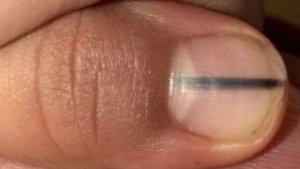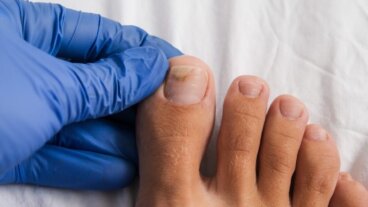A Black Line on Your Nails Could Be a Sign of Cancer


Written and verified by the doctor Nelton Abdon Ramos Rojas
How often do you go to a nail salon for a manicure? Jean Skinner works as a beauty therapist in Uckfield, East Sussex (UK), and shared a story that scared more than a few people. It was about a black line on a client’s nail.
It all started when one of her clients asked her to apply a dark color on their nails to cover the black lines that went across them. However, Skinner advised her to consult a doctor because she knew that cancer symptoms can sometimes present themselves in this way.
In fact, a diagnosis confirmed that her client had ungual melanoma, a type of cancer. These dark or bluish spots don’t just appear on nails and can also differ in size, color, and shape. Jean Skinner’s story represents the importance of paying attention to certain signals in our bodies.
Causes of a black line on the nails
Dark marks on the nails aren’t always linked to cancer. In fact, in the majority of cases, they’re due to other benign conditions. These are some of the situations in which their presence is completely normal:
- Use of medications. The side effects of some drugs include nail pigmentation after several days of use. Fortunately, it disappears once the medication is stopped.
- During pregnancy. It’s possible for nails to acquire a brownish stain during pregnancy with no serious consequences.
- Dark complexion. People with a dark complexion may present dark lines on their nails without the presence of any illness. In these cases, the alteration is due to a higher concentration of melanin in the area.
- Infections. The appearance of nail fungus can cause a change in nail color. In addition, there are other infections such as endocarditis that can cause the appearance of small hemorrhages in the nail bed. These are known as splinter hemorrhages.
- Bruising. When there’s a mixture of brown and red spots, it’s probably due to a blow to the nail.
When to worry about a black line
Although rare, nail melanoma can occur at any age, even in childhood. The symptoms are rather vague, and, according to some research, the condition doesn’t tend to be diagnosed until the later stages. Usually, the width of the line is greater than 4mm and it isn’t only one color, but there are different shades of brown in the same line.
It changes as time goes by, and generally, the skin around the nail is also dark in color. In most cases, ungual melanoma doesn’t just affect one nail. However, there are other symptoms that can present themselves in various areas of the body such as the toes and scalp.
Is a black line really dangerous?
Melanoma is the most aggressive kind of skin tumor because it spreads rather quickly into other organs. It even spreads to distant organs such as the small intestine, the eyes, the brain, and even the heart.

Treatment of melanoma
There are different ways to treat skin melanoma. It all depends on the state of the tumor and the patient’s physical conditions. These are some of the treatments:
- Radiotherapy. This method keeps the cancerous cells from growing. It’s a localized treatment which means it only affects the area where the melanoma is located.
- Surgery. The most common method. The tumor and the tissue found around it are removed. The goal is to keep cancer from reproducing in the areas around it.
- Chemotherapy. Used when melanoma has spread to other parts of the body. The patient is given a combination of drugs, including localized applications.
- Immunotherapy. The goal of this treatment is to increase the strength of the immune system.
You might also like to read: What Is a Malignant Melanoma?
Prognosis
As in other cases, a nail melanoma prognosis depends on how early a diagnosis is made and treatment is begun. Unfortunately, the prognosis tends to be worse than in instances of cutaneous melanoma because the diagnosis, in many cases, is made late.
It’s essential for the primary care physician to be familiar with the characteristics of this type of melanoma, as this increases the chances of successful treatment.
Prevention of melanoma
One of the largest causes of melanoma is the lack of care surrounding exposure to the sun. You must keep the following in mind:
- Avoid exposure to the sun during peak times (between noon and 4 pm).
- Get in the habit of using sunscreen every day. Apply it half an hour before going out, especially if you’re going to a pool or the beach.
- Drink at least two pints of water as the sun dehydrates your body and you need to regulate your body temperature.
- Avoid tanning. Exposure to UV rays speeds up the skin aging process and increases the risk of skin cancer.
- Pay attention to any irregularity. Don’t disregard any of the possible warning signs like lines on your nails or changes in color and size of moles.

We recommend you read: Non-toxic Natural Oils That Can Be Used as Sunscreen
If you have a black line on your nails, consult your doctor
It’s extremely common to confuse melanoma with benign diseases such as onychomycosis(nail fungus) or common bruises. For this reason, patients tend not to seek help until the condition is quite advanced.
Don’t self-diagnose. Consult a dermatologist if you find any skin abnormalities. It’s the only way to obtain a proper diagnosis and suitable treatment.
All cited sources were thoroughly reviewed by our team to ensure their quality, reliability, currency, and validity. The bibliography of this article was considered reliable and of academic or scientific accuracy.
- Daniel, C. R. & Scher, R. K. (1985). Nail Changes Caused by Systemic Drugs or lngestants. Dermatologic clinics, 3(3), 491-500. Disponible en: https://pubmed.ncbi.nlm.nih.gov/3830510/
- Domingues, B., Lopes, J. M., Soares, P., et al. (2018). Melanoma treatment in review. ImmunoTargets and therapy, 7, 35-49. Disponible en: https://www.ncbi.nlm.nih.gov/pmc/articles/PMC5995433/
- Erpolat, S., Eser, A., Kaygusuz, I., et al. (2016). Nail alterations during pregnancy: a clinical study. International Journal of Dermatology, 55(10), 1172-1175. Disponible en: https://pubmed.ncbi.nlm.nih.gov/27097299/
- Faico, K., Martins, R., Santos, C., et al. (2020). Total melanonychia of 20 nails as a rare manifestation of vitamin B12 deficiency. JAAD Case Reports, 6(4), 372-373. Disponible en: https://pubmed.ncbi.nlm.nih.gov/32258326/
- Heistein, J., Acharya, U., Kumar, S., et al. (2022). Malignant Melanoma. StatPearls. Disponible en: https://www.ncbi.nlm.nih.gov/books/NBK470409/
- Jefferson, J. & Rich, P. (2012). Melanonychia. Dermatology Research and Practice, 2012, 1-9. Disponible en: https://www.hindawi.com/journals/drp/2012/952186/
- Díaz, M., Izquierdo, M., Fernández, O., et al. (2021). Melanoma subungueal: un reto diagnóstico para los médicos. Revista Médica Electrónica, 43(2), 3279-3288. Disponible en: http://scielo.sld.cu/scielo.php?script=sci_arttext&pid=S1684-18242021000203279
- Littleton, T. W., Murray, P. M. & Baratz, M. E. (2019). Subungual melanoma. Orthopedic Clinics, 50(3), 357-366. Disponible en: https://www.orthopedic.theclinics.com/article/S0030-5898(19)30038-0/fulltext
- Mole, R. J. & MacKenzie, D. N. (2021). Subungual melanoma. StatPearls. Disponible en: https://www.ncbi.nlm.nih.gov/books/NBK482480/#article-37664.s15
- Muneer, H. & Masood, S. (2020). Psoriasis of the Nails. StatPearls. Disponible en: https://www.ncbi.nlm.nih.gov/books/NBK559260/
- Verghese, A., Krish, G., Howe, D., et al. (1990). The harlequin nail: a marker for smoking cessation. Chest, 97(1), 236-238. Disponible en: https://pubmed.ncbi.nlm.nih.gov/2295246/#:~:text=Alterations%20in%20the%20morphology%2C%20structure,nicotine%20sign%22%2D%2Dis%20common.
This text is provided for informational purposes only and does not replace consultation with a professional. If in doubt, consult your specialist.








